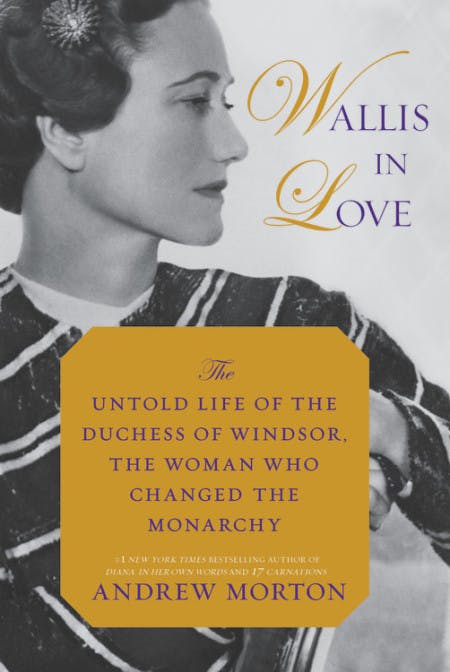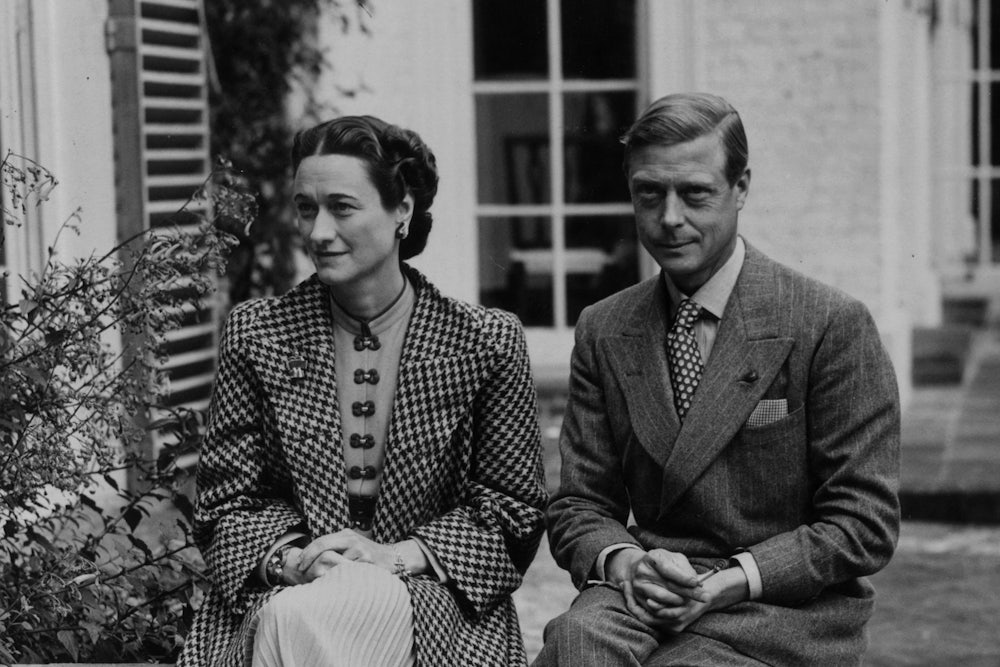The life of Wallis Simpson, the woman who almost brought down a monarchy, has been told many times—by the woman herself, by her husband the erstwhile King Edward VIII, and by several biographers. It has been told by Madonna in 2011’s W.E., and most recently by Netflix in The Crown. Actresses from Jane Seymour to Gina McKee have struggled to nail her distinctive accent: Southern belle meets arriviste aristocrat. Now it’s the turn of Andrew Morton—the tabloid reporter whose 1992 “true story” of Diana, Princess of Wales made its author fistfuls of cash—to narrate the “untold life” of one of the most infamous and least interesting women in twentieth-century history.

The girl born Bessie Wallis Warfield in Baltimore in 1896 lost her father by the time she was five months old, and grew up dependent on the largesse of her capricious uncle. No wonder, then, that she learned early on to mold her personality into the shape a rich man wanted. Her first marriage, at the age of 20, tied her to a naval pilot who turned out to be a jealous alcoholic, and her second to a serious, cultured Anglophile and shipping heir who—even worse—took her to live in damp, dull London. Throughout her life, where Wallis lived and traveled, what she did and who with, was dictated entirely by her man, or men, of the moment. No wonder she was furious most of the time.
In the hour of her notoriety, when Edward VIII abdicated the throne in December 1936 in order to marry her, everyone had a theory about Wallis. While strenuously denying the wilder ones—that she was a sexual dynamo trained in an “oriental” brothel, or a hermaphrodite, or simply a witch—Morton nevertheless airs them, salivating especially over the “deliciously unprovable urban legend” of the brothel. Pursuing these theories as though they had any basis in fact, he fails to see the connection between the myth of Wallis’s sexual prowess and his own acceptance the idea that a women’s seductive power could persuade powerful men to do anything. “The prince was Thelma’s to lose, not Wallis’s to win,” Morton asserts, of Edward’s transfer of affection from one mistress to the next—as though the man who would be king was a pawn, rather than the guy who owned the chess set.
In fact, there’s little about Wallis that feels stable through the story, except for the fact that she’s thin and blue-eyed, with big hands, somewhat masculine features, and a voice that nobody can stand. In her diary, the socialite Courtney Letts sneers at Wallis’s low social status, but allows that she possessed “the hard-boiled slapstick wit which always amuses.” Courtney went on to marry Felipe Aja Espil, a diplomat and ex-lover of Wallis’s, described as a “smoothly charismatic Latin Casanova.” Their affair turns Wallis into an equally clichéd soap opera diva, her passion accompanied by the “brooding handmaidens” of “jealousy, possessiveness, and rage.”
Espil, however, is not the lover that the book’s title promises. That honor goes to the rather less operatically-named Herman Rogers, a staunchly loyal friend to Wallis so long as he was safely married to another woman. She claimed was the only man she ever loved—or, at least, that’s what she told his second wife on the latter’s wedding day—and it’s convincing insofar as Wallis seems to have wanted most what she couldn’t have. Rogers, for his part, comes across as the kind of paternalistic man obsessed with protecting his damaged female friends, who prides himself on being the only one to truly understand them. He tells her ghostwriter, of Wallis’s first husband: “he beat, her—and she loved it.” Morton seems to think this kind of man is unusual.
The revelation that Wallis’s heart really belonged to Roger punctures the usual narrative about Wallis and Edward VIII, making it hard to see their controversial marriage as a love story for the ages. It is difficult, for instance, to take at face value the words the king broadcast to the nation in December 1936, that he could not shoulder the burden of his birthright “without the help and support of the woman I love.” But Morton is not the first to suggest that the abdication was the king’s choice alone, and that Wallis only provided him with an excuse to escape from a role he hated—or that for her, it was a disaster. Once he stepped down, she was trapped into marriage with a man she was coming to despise, who had given up the one thing she had ever truly seen in him.
There’s no one to root for in Wallis Simpson’s story. Take the side of the Establishment, trying to preserve the dignity of the Crown against a middle-aged playboy determined to wreck it all out for the love of his social-climbing mistress, and you end up siding with British class prejudice and sexual repression. Take the side of the plucky, wrong(ish)-side-of-the-tracks gal from Baltimore who stole a king’s heart in defiance of his whole stuffy country, and whoops, your heroine is a Nazi.
In his earlier book, Seventeen Carnations, Morton detailed the Duke and Duchess’s close relationship with several higher-ups in Hitler’s cabinet. His title refers to the flowers allegedly delivered to Wallis by Joachim von Ribbentrop, Hitler’s future foreign minister, with whom she was rumored to be having an affair. Neither the extent of their involvement, nor the allegation that Wallis might have been spying for the Germans, has never been proven decisively, yet it is quite clear that the Duke and Duchess were enthusiastic supporters of the Nazi regime. They had not simply befriended the Nazis in the interest of avoiding another war, nor in petulant rage at the way the British establishment had treated them. Morton calls Wallis “nonchalantly racist” and anti-Semitic only as part of an “automatic social reflex”—a product of her time and place, helpless to the shaping effect of her culture.
It’s a delicate sidestep of the story he’s actually telling. Wallis fully embraced the segregationist ethos of her home town of Baltimore, which in 1910 introduced what the New York Times called “the most pronounced ‘Jim Crow’ measure on record,” making it illegal for a black person to buy a home on a majority-white street. In 1925, after she found out that divorce was not as easy as it was rumored to be in either Paris or China, Wallis moved into a hotel in Virginia in order to establish residency in the state and make her separation from her first husband official. There, Morton notes, she whiled away her time with eugenicist Madison Grant’s notorious screed The Passing of the Great Race. For a woman who claimed never to have read a book, her eager absorption of the key tract of scientific racism, a book Hitler called his “Bible,” implies something more than polite acquiescence to the norms of her time.
And this, in the end, is the real point. Whether or not the Duchess was a spy or Nazi collaborator, it is clear that she and her husband shared a distinctive worldview. Anyone writing their story has a responsibility to say more about this than Morton does in his book. If you look up “racism” in the index, you get a description of a single incident, when the Duke was governor of the segregated Bahamas, and his 44-year-old wife reportedly shook the hand of a “coloured person” for the first time. The couple’s racism cannot be reduced to a remark, an incident, or even a pattern of behavior—it was an entire system of thought and belief, underpinning the way they saw the world and acted within it. It may not be the only reason why these pathetic exiles were terrible people who deserved to be footnotes in history, but it’s the best one.
Passing over these difficulties, Morton portrays Wallis’s world as an endless social cabaret, populated by numbing lists of baroque names and sexual scandals without consequence. We’re repeatedly told, but never shown, that people are urbane and witty and intelligent. Fascists come and go. Characters who pop up frequently in the book don’t develop, but seem to get smaller each time they are reintroduced under labels like “Wallis’s love rival” or “the duke’s boon companion.” Morton piles on adjectives in twos and threes, in alliterative rather than illustrative combinations—Edward is “simpering, self-pitying, and spoiled” yet on the next page, charming and authoritative, and then again, lonely and restless.
The liveliest writing in the book comes in the acknowledgements section, when Morton describes his own heroic pursuit of secretive documents, lost archives, and forgotten minor characters in the Windsor drama. He takes a ride in a vintage Rolls Royce with a “duchess fanatic, royal collector, and part-time drag queen” and locates the night nurse who was by the former king’s side when he died in Paris in 1972. Her revelations, decades later, are not especially revealing, but they are poignant: She claims that the Duchess spent no time with her dying husband, even though he called for her constantly. Wallis’s claim to have held his hand as he breathed his last was, it seems, a self-serving fabrication.
This should not perhaps come as a surprise. Wallis was known for such revisions and evasions. Wallis’s erstwhile ghostwriter, a humorist named Cleveland “Clip” Amory, tells Morton that he quit after six months because the Duchess so determinedly whitewashed memories of her life. There was not much left for him to work with.
